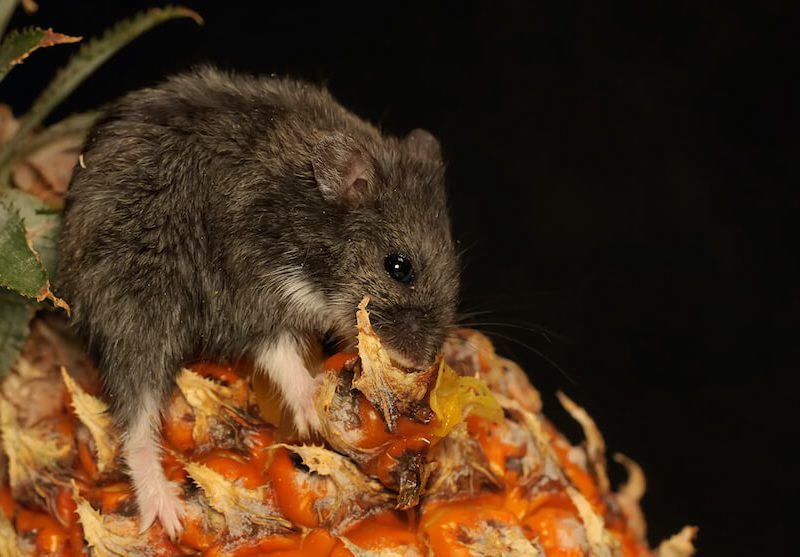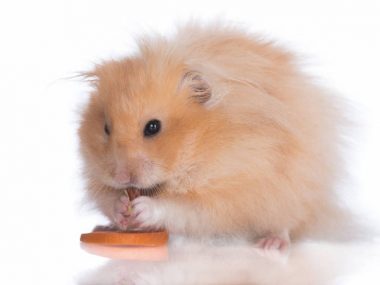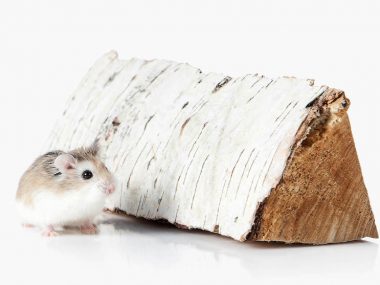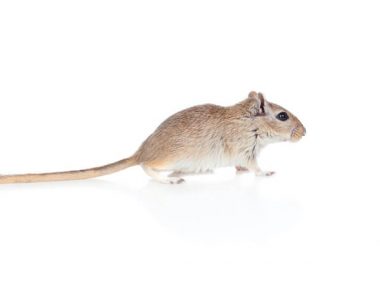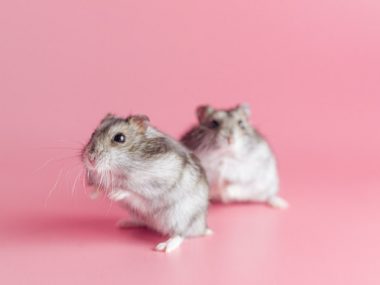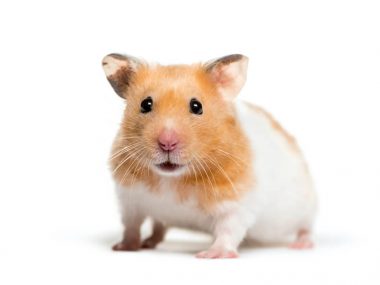We have a little hamster who doesn’t know enough to come in out of the cold in the wild. Instead of seeking the cover of warm burrows deep underground, it goes out to run marathons! Meet the Campbell’s dwarf hamster — a lesser-known breed you may be dire to meet!
Table of Contents
What Is A Campbell Dwarf Hamster?
The Campbell dwarf hamster (Phodopus campbelli) is a subspecies of Djungarian (Phodopus sungorus.) Campbells are often called “Campbell’s,” “Campbell,” or “Campbell Russian dwarf hamster.” At first glance, a Campbell looks similar to a common house mouse (without the long tail).
Where Do Campbell Dwarf Hamsters Come From?
Campbell dwarfs were named after W.C. Campbell, who collected several of these hamsters on an expedition in 1902.
Campbell dwarfs are native to Mongolia and the northeast region of China. The American Society of Mammalogists published an article on the Campbell species noting evidence of the hamster’s existence dates as far back as the Ice Age through fossil records.
Caravans traveling through the native regions where Campbell dwarfs thrive have managed to capture some of these hamsters. It is perhaps through these captures that Campbells made their way to other countries. Today, it’s not uncommon to find wild Campbell dwarf hamsters finding their way into yurts and various buildings in Mongolia and parts of China.
Campbell dwarfs lineage is traceable back to the ancient hamster parentage millions of years ago. The first hamster was born into existence as a result of mating between two different species of Rodentia (Peromyscus leucopus and Clethrionomys glareolus.) According to a research study published (“Molecular phylogeny of the Cricetinae subfamily based on the mitochondrial cytochrome b and 12S rRNA genes and the nuclear vWF gene,”), Phodopus did not separate into its own genus until about 8 million years ago.
Campbell Dwarf Hamster Characteristics and Traits
Campbell dwarfs are small and compact in size. They are typically a brownish color with white undersides. A prominent dark stripe runs down the back.
Campbell Dwarf Hamster At A Glance
- Coat: short-hair
- Colors: brown, white
- Patterns: dominant spot
- Self or Agouti: agouti
- Eyes: black, red
- Size: up to 4 inches
- Lifespan: up to 2 years
- Diet: herbivore, granivore
- Sexual maturation: 23 days
- Temperament: high energy
- Level of care: moderate
Campbell Dwarf Hamster Coat Characteristics
Campbell dwarf hamster colors are generally brown with a creamy underside. Unlike their other dwarf counterparts, Campbells don’t have changing coat colors or patterns worth mentioning. Their predominant brown color is highlighted by the dark dorsal stripe.
Eyes, Ears, and Tail Characteristics
Campbell dwarfs have a stubby tail that almost appears as if it’s nonexistent. Their eyes are typically black but may also be red. Its perky ears are often the same brown color as its dorsal side.
Campbell Dwarf Hamster Lifespan
As much as we want our hamsters to live a long time, they don’t. Hamsters average a lifespan of 1-3 years even under the best conditions. According to the National Hamster Council in the U.K., Campbell dwarfs live about two years.
This lifespan may be shorter if the hamster develops diabetes (which dwarfs are known to have) or if the hamster sustains an injury from being dropped or improperly handled. Small children handling dwarf hamsters should always be closely supervised because these hamsters are quick and small and notorious at jumping out of hands.
How Big Will A Campbell Dwarf Hamster Get?
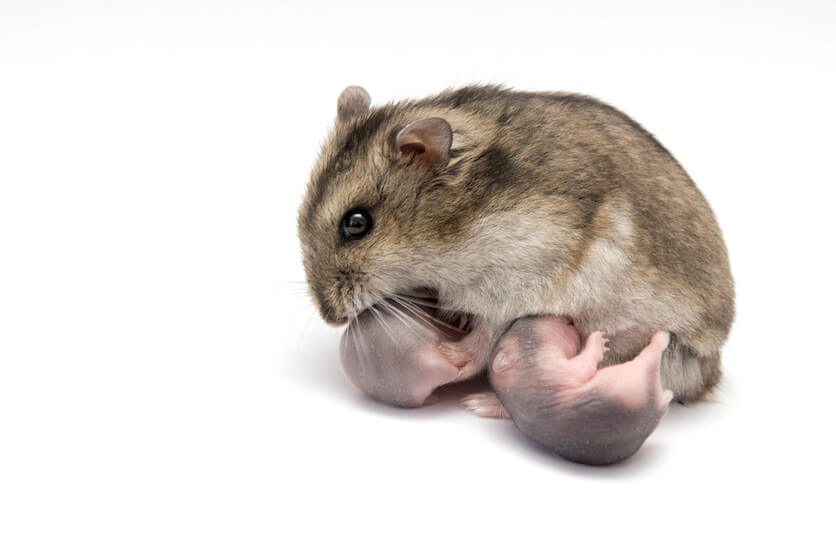
Campbell dwarfs grow to be about 4″ long as adults and weigh up to two ounces. They are roughly about the size of an extra-large egg. Dwarf hamsters are smaller compared to Syrian (Golden) hamsters. Dwarfs such as Campbell and Djungarian get to be 3-4″ whereas Roborovoski dwarfs are about 2″ (they are the smallest hamster species.)
Campbell Dwarf Hamster Behavior
One trait that sets Campbells apart from other hamsters is how it reacts to cold climates. Most wild hamsters hibernate to conserve energy since the food supply is limited. However, Campbells do just the opposite. Instead of finding a nice warm burrow to snuggle up in, they become energetic and don’t give the chilling temperatures a second thought. Should those temperatures become extremely cold, they may (with hesitation) decide to find shelter.
As with any other hamster species, Campbell dwarfs are nocturnal. They sleep during the day and become active during the night. In the wild, this benefits hamsters since they can forage for food in the dark from the safety of their underground burrows. Hamsters are capable of traveling miles in one night looking for food.
Do Campbell Dwarf Hamsters Like To Be Held?
Any hamster that has not gone through the appropriate handling (taming) will not like being held or touched. Should you happen to acquire your hamster from a reputable breeder, a breeder most likely has hamsters up for adoption that are handled/tamed. Pet store hamsters are, in all likelihood, not tame. It’s important to understand this because when taking a new hamster home that has not been handled/tamed, the odds of being bitten are very high.
Taming Campbell’s Dwarf Hamster
Let’s say you’ve acquired a hamster from a pet store. It’s going to be fairly unsettled, hypervigilant, and non-sociable. You can’t blame them because they have most likely been shuttled to different places. When taking one of these little guys home, the car ride home will be stressful, as will the new environment at home. Quiet is the key, and leaving them alone is a must for a few days.
Now, if you’ve adopted your hamster from a breeder, and the hamster has been socialized, it too can find the car ride home stressful. However, the amount of time you’ll need to invest in getting it acquainted with you should be shorter.
Acclimation Period
- Upon arriving at home, place the hamster into its cage.
- Place the cage in a quiet area away from noises.
- For the first few days, don’t put your hands into the cage. If you do, you’ll probably get bitten. Your interaction with the hamster should be limited to feeding, watering, and talking to it.
- Hamsters come to recognize their owner’s voices, so talking to them helps them to get to know you.
- Keep children and pets away from the cage.
- If you place a small item with your scent on it (scarf, sock, hanky, etc.) inside the cage, your hamster will become acquainted with your scent.
- On about the third day, you can start handling/taming it.
Daily Handling
- Always wash your hands before and after each handling session.
- All handling sessions should be done at floor level in case the hamster jumps out of your hands.
- Scoop your hamster up with your hands. If they are not comfortable coming to you, continue trying until it does. This may take a few days.
- Talk to your hamster as you scoop it up.
- Handling sessions should be limited to 15 minutes each day.
- Expect to be bitten because it’s a part of handling.
Just a word of advice: never touch/startle a sleeping hamster because its first reaction is to bite.
Campbell Dwarf Hamster Care
The moment you drive off with your new hamster, you accept full responsibility to care for and nurture it for its lifetime. No matter how large or tiny an animal is, the responsibility and care are a big undertaking.
Campbell Dwarf Hamster Cages
When setting up a hamster cage, there are a few things you’ll need to have.
- Nesting box
- Bedding (cedar and pine shavings should never be used)
- Wheel
- Water bottle
- Food bowl
- Toys
Cage Placement
Your hamster’s cage should be placed in an area where it’s warm (about 64-79 degrees (F.) The cage should be on a flat surface that will adequately support it. A few places to avoid placing a cage near appliances, TVs, stereos, fireplaces, windows, exterior doors, or air vents.
Campbell Dwarf Hamster Food
Campbell dwarfs eat insects, plant matter, grains, and seeds. They should be fed a good quality pellet diet with the occasional treat of fresh produce.
Toxic Foods To Avoid:
- Alcohol
- Caffeine (chocolate, tea, coffee, etc.)
- Citrus (oranges, lemons, limes, grapefruit, etc.)
- Nightshade vegetables (potatoes, tomatoes)
- Onions
- Garlic
Do Campbell Dwarf Hamsters Bite?
Campbell dwarfs will bite if they are startled, threatened, scared, hurting, or they haven’t been handled/tamed. If they don’t know you, they may also bite.
Can Campbell Dwarf Hamsters Live Together?
Most hamsters are solitary and do fine living alone. Syrians are definitely not cagemate-friendly. Dwarfs may be a bit more accepting. If you do decide to pair hamsters, careful monitoring is a must to keep tabs on how they are getting along. Females can be feisty and aggressive towards one another and to males.
How Much Do Campbell Dwarf Hamsters Cost?
- Campbell Dwarf hamster: $10-$20 (USD)
- Cage: $15 – $300 (USD)
- Accessories (wheel, nesting box, bedding:) $30 – $65 (USD)
- Food: $5 – $15 (USD)
Another Dwarf That Doesn’t Fall Short
If you invest the time into handling a Campbell dwarf and being patient with it, you’ll have a wonderful pet. If you’re considering a dwarf hamster, the Campbell won’t disappoint.
